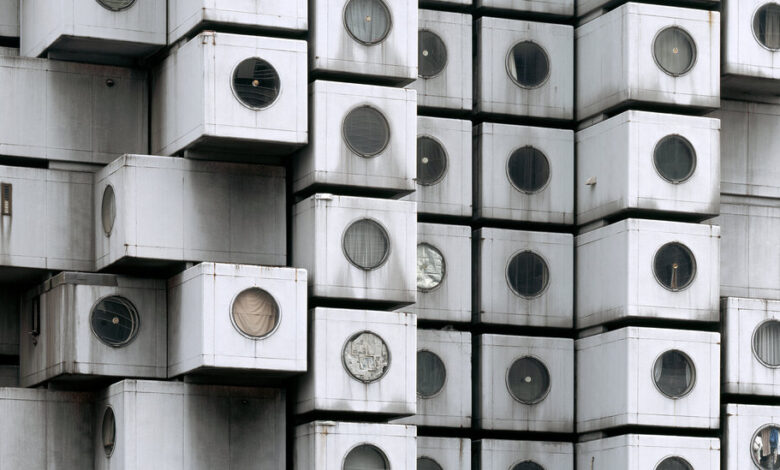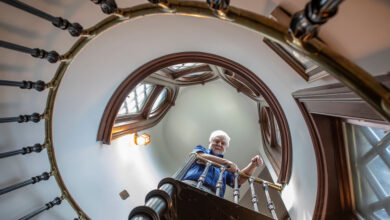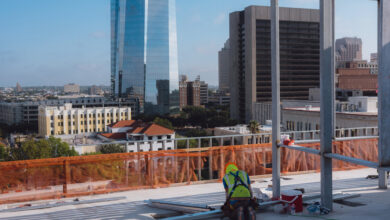In Tokyo, Rescuing the Residential Spaceship That Fell to Earth

[ad_1]
In 1972, residents of Tokyo looked up to see something extraordinary looming over downtown. It looked like something out of a science-fiction film — a futuristic tower composed of 140 detachable capsules, each suitable for a single resident and with a porthole looking out, like a pile of eyes fixed on the city.
With its modular design and minimal aesthetics, the 13-story Nakagin Capsule Tower was a marvel of 20th-century design intended to express a postwar Japanese theory of architecture as a living organism. Metabolism, as explained by the architect Kisho Kurokawa, who designed the tower, envisioned cities and buildings with modular parts that could be attached and detached as needed, just as some organisms grow new appendages.
“If you replace the capsules every 25 years, it could last 200 years,” Kurokawa said in an interview in 2007, the year he died. “It’s recyclable. I designed it as sustainable architecture.”
Each capsule measured eight by 13 feet and was affixed to one of two central towers of reinforced concrete. But over the years, many of them were abandoned and left to decay, and residents finally decided to let the building die rather than save it. Lamenting its fate, The New York Times called the Nakagin tower “an architectural tragedy.”
After years of delays, the Nakagin Capsule Tower was dismantled in late 2022, its 140 prefabricated capsules plucked from their sockets one by one and discarded. Most were unsalvageable. But 23 pods managed to survive — pieces with no puzzle.
Now, after some refurbishment, these orphan capsules are embarking on a surprising second life, pollinating new architectural ideas across Japan and the world, where they’re being repurposed into art spaces, museum pieces and even holiday accommodations.
“Even though we couldn’t save the building, Kisho Kurokawa’s original idea of capsules as interchangeable, mobile elements gave us the impetus to preserve them,” said Tatsuyuki Maeda, a former Nakagin resident and now the head of the Nakagin Capsule Tower Building Preservation and Regeneration Project.
Mr. Maeda, 56, fell in love with the tower when he first saw it as a boy, imagining it to be a base for the superhero of Japan’s “Ultraman” science-fiction franchise. “I felt drawn to its unique exterior,” he said. “I wanted to look out through one of those round windows someday.”
Since the demolition, Mr. Maeda has fielded requests from wealthy people to buy the pods, but they’re not for sale. Putting these Metabolist castaways in the care of museums and commercial facilities was the best solution.
“The concept was that when a capsule became old, it would be replaced with a new one,” he said. “This meant that the capsule itself could be moved. By exhibiting capsules around the world, I want as many people as possible to understand this concept.”
All 23 have been reborn — their asbestos removed, their insides and outsides repaired and repainted, and in some cases new furnishings installed. Now they’re finding a new purpose as messengers from a bygone design era. An Osaka steel company placed one on a trailer undercarriage and has been displaying it at trade shows in Tokyo, Nagoya and Osaka to promote its design brand. Another capsule was acquired by the Museum of Modern Art, Wakayama, which Kurokawa’s studio designed in 1990. Kurokawa’s own capsule found its way to the San Francisco Museum of Modern Art.
“It is hard to find Metabolist drawings available, so when we heard that the Nakagin Tower residents were unsuccessful in their bid to restore the towers and it was going to be demolished, we decided to go and see the demolition and the saved towers to begin a conversation,” said Jennifer Dunlop Fletcher, the Helen Hilton Raiser Curator of Architecture and Design at SFMOMA.
Erected on the edge of the upscale Ginza district, Kurokawa’s capsule tower reimagined minimal modern living. Each capsule was just large enough for a bed, closet, workstation, bathroom and a porthole window. Deluxe versions came with a built-in Sony stereo, tape deck, color TV and digital clock.
At first, the pods were aimed at busy salarymen looking for a pied-à-terre downtown rather than a long commute. “This ‘capsule’ will provide a good living space and a secluded environment in which to select and evaluate business data,” proclaimed an early sales brochure, advertising features like housekeepers, typewriters and calculators.
And more than just a convenient place to stay, Nakagin was a living art installation — an expression of the postwar Japanese philosophy mixing modern architecture with organic biological growth.
The Metabolist movement, said Ms. Fletcher, “emphasized proof of concept, light environmental footprint and an early interest in biotechnology.”
But like many living bodies, Kurokawa’s tower encountered unexpected maladies.
Upon its completion in 1972, all the units were sold and the building basked in critical acclaim. But second-generation owners who had inherited capsules weren’t as interested in using them, much less in paying for replacements when the steel shells began to deteriorate. The capsules had to be removed for renewal, which was prohibitively expensive. Asbestos was another major problem. As the decades passed, many units became corroded, and netting was placed over the structure to prevent pieces from crashing to the street below. Units were left vacant or used for storage.
In 2018, a real estate company purchased the land, along with some of the capsules, with plans for redevelopment. But the pandemic infected those plans. Since the tower was now certain to be knocked down, preservationists agreed to pay part of the demolition cost to the real estate company in exchange for the transfer of the 23 capsules free of charge.
Despite its premature demise, the tower had become an icon of Tokyo, attracting design enthusiasts from around the world. Even though most owners decided to sell, Nakagin had developed a small community of residents. In place of the salarymen of old, it drew writers, architects, photographers and other creatives. They held drinking parties, hosted famous visitors (among them Francis Ford Coppola and Keanu Reeves) and dreamed of saving the structure from the proverbial wrecking ball.
Takayuki Sekine bought two capsules in 2005 while he was a manager at a regional chamber of commerce. He spent weekends there for the next 15 years, always welcoming curious visitors.
“Everyone was very happy and enjoyed the unique space, with many saying it was their favorite building in the world,” said Mr. Sekine, 61.
Shojiro Okuyama, 46, a journalist, bought a unit in 2016 in a bid to help save the building.
“We had the preservation project going at the time, but even so it was heartbreaking to see my own capsule being scrapped,” he said. “I was first drawn to it because of the architecture, but it was the community that I came to really love. I hope the preserved capsules can spread that sense of community across borders.”
Refurbished capsules are now drawing fans in Ginza, Tokyo’s upscale shopping and nightlife district. The entertainment company Shochiku, known for its Kabuki theater, has put two on permanent display. At a recent gathering in its purpose-built gallery, Wakana Nitta, a musician who goes by the name Cosplay DJ Koe-chan, set up her turntables between the pods and began spinning tunes from anime shows and sci-fi films.
A former resident, Ms. Nitta, now 44, meticulously documented the tower’s dismantling. At the recent event, her photos of cranes carrying capsules out of the structure were on display in a capsule that had been stripped down to its frame; the other, refurbished, displayed images of her life in her own pod, gazing out its porthole at Tokyo.
“It felt like aliens had taken me aboard a spaceship,” she laughed. “With the cranes lifting them, the capsules finally flew through the sky like UFOs.”
The Nakagin tower also lives on digitally. The architecture and design firm Gluon took more than 20,000 photos with drones and single-lens reflex cameras to record the entire building with civil-engineering laser scanners. The result is a precise 3-D rendering of the structure, rust stains and all, which has been uploaded to the internet for posterity.
For those who want to experience the real thing, Mr. Maeda and his colleagues plan to open a seaside “capsule village” in Kanagawa Prefecture, south of Tokyo, this year. Five refurbished Nakagin units will be set up along the coast, their portholes pointed toward the Pacific. The idea was inspired by a 1972 Kurokawa scheme outlined in a book that is on display at the only other place where you can sleep in one of his original pods: Capsule House K, the architect’s own former cottage in the hills of Nagano Prefecture west of Tokyo. Now a $1,400-a-night Airbnb rental, it comprises four capsules, made at the same time as those for the Nakagin tower, attached to a concrete core. Two are identical to the Nakagin units, one is a kitchen, and one is a chashitsu, or traditional Japanese tearoom.
“He grew up in Aichi with a backyard tearoom where he and his siblings did their studies and played hide and seek,” said Kurokawa’s son, Mikio Kurokawa, 58, while showing a visitor the capsule on a recent afternoon. “It’s said that a room this size allows Japanese to feel most relaxed.”
Back in Tokyo, the Ginza Six shopping mall has unveiled another Nakagin homage: a mock-up of the Nakagin tower erected on a rooftop skating rink, with a capsule refurbished as a retro music room set up at a street-level entrance.
“How do the people of today, who live in the future, feel about the ‘future ideas of the 1970s’ that the Nakagin building held, and how will they connect these ideas to our own future?” asked Yoshiro Nishi, a spokesman for YAR, a design studio that did the interior. “We’ll be happy if this exhibition can serve as a bridge from the past to the present and further into the future.”
Thus far, 16 of the 23 rescued capsules have found new homes. As for Nakagin’s legacy, it lives on in a variety of buildings: Kurokawa created the first capsule hotel, the Capsule Inn Osaka, which opened in 1979. Its units, stacked in twos, were only the width of a single mattress, but the concept was adopted in cities throughout Japan and even exported. It was an early example of how modular architecture, now seen in everything from residences to airports, can inspire.
“Under the Metabolism concept, the tower would remain and the capsules would be discarded like old cells,” said Mikio Kurokawa. “The fact that due to the strong feelings of many people, some capsules have survived and been restored as new cells for new locations is perhaps even more interesting than Metabolism itself. Their architect would have been delighted.”
[ad_2]
Source link






